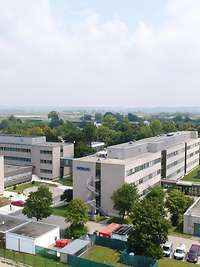
About the agency
The Bundeswehr Research Institute for Materials, Fuels and Lubricants Tests which textiles, fuels and lubricants and chemicals are suitable for the Bundeswehr.


In future, the Bundeswehr will work on new camouflage materials at WIWeBWehrwissenschaftliches Institut für Werk- und Betriebsstoffe in Erding with partners from industry and research. For this purpose, the pilot plant for camouflage materials was inaugurated in an official ceremony at the Bundeswehr Research Institute for Materials, Fuels and Lubricants (WIWeBWehrwissenschaftliches Institut für Werk- und Betriebsstoffe) at the beginning of December.
For years, Bundeswehr personnel at WIWeb have been conducting research into materials suitable for making aircraft lighter, more stable and more functional. A collaboration with the German Aerospace Center (DLRDeutsches Zentrum für Luft- und Raumfahrt), Airbus and the Bundeswehr University Munich intends to research and develop new camouflage materials for European aircraft.

from left to right: Dr. Kerstin Huber (DLRDeutsches Zentrum für Luft- und Raumfahrt), Prof. Dr. Philipp Höfer (UniBwM), Thomas Grohs (Airbus) and Priv.-Doz. Dr. Jens Holtmannspötter (WIWeBWehrwissenschaftliches Institut für Werk- und Betriebsstoffe) inaugurating the pilot plant for camouflage materials at WIWeBWehrwissenschaftliches Institut für Werk- und Betriebsstoffe in Erding
Bundeswehr/Maria AignerReconnaissance technology has improved continuously in the past years. Detection by means of radar, infrared and acoustic sensors is continuously advancing. At the same time the demand for camouflaged aircraft in the armed forces is rising. Therefore, the Bundeswehr decided to purchase American F-35 combat aircraft with camouflage technology last year.
Radar camouflage for aircraft cannot be retrofitted, it must be incorporated in the development process. For instance, the shape of the aircraft and the engine integration must ensure that the aircraft’s radar cross section and its infrared and sound signatures are minimized. Radar absorbing materials are also playing an increasing role.
The camouflage materials currently used for combat aircraft require a high level of maintenance and are susceptible to environmental influences. Particularly joint European defense projects require the creation of expertise and production technologies including the appropriate supply chains for camouflage technology in Germany and Europe.
Several doctoral students will research available radiation absorbing materials and also develop new materials for research purposes at laboratory level. For this purpose they will investigate and develop new processes and technologies.

At the pilot plant for camouflage materials at WIWeBWehrwissenschaftliches Institut für Werk- und Betriebsstoffe in Erding, doctoral students investigate, research and develop camouflage materials.
Bundeswehr/Andreas JakobInitially, the focus will be on changing the functionalities of existing components and materials in such a way that they acquire camouflage properties.
All project partners are committed to making “camouflage technology made in Germany” a reality in the future.

The Bundeswehr Research Institute for Materials, Fuels and Lubricants Tests which textiles, fuels and lubricants and chemicals are suitable for the Bundeswehr.